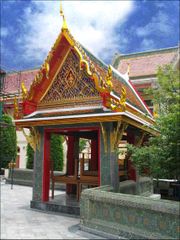
Sala (architecture)
Encyclopedia

Pavilion (structure)
In architecture a pavilion has two main meanings.-Free-standing structure:Pavilion may refer to a free-standing structure sited a short distance from a main residence, whose architecture makes it an object of pleasure. Large or small, there is usually a connection with relaxation and pleasure in...
, used as a meeting place and to protect people from sun and rain. Most are open on all four sides. They are found throughout Thailand
Thailand
Thailand , officially the Kingdom of Thailand , formerly known as Siam , is a country located at the centre of the Indochina peninsula and Southeast Asia. It is bordered to the north by Burma and Laos, to the east by Laos and Cambodia, to the south by the Gulf of Thailand and Malaysia, and to the...
in Buddhist temple areas, or Wat
Wat
A wat is a monastery temple in Cambodia, Thailand, or Laos. The word "wat" means "school".- Introduction :...
s, although they can also be located in other places. A person who builds a sala at a temple or in a public place gains religious merit. A sala located in a temple is called a salawat. Some temples have large salas where laity
Laity
In religious organizations, the laity comprises all people who are not in the clergy. A person who is a member of a religious order who is not ordained legitimate clergy is considered as a member of the laity, even though they are members of a religious order .In the past in Christian cultures, the...
can hear sermons or receive religious instructions. These are called sala kan parian (pavilion where monks learn for the Parian examination).
In Thailand, they have many purposes similar to the roadside pavilions of Asoka. In rural areas, travelers can use them to rest and reflect. These salas are called sala asai. One at the roadside is a sala rim thanon and may be used as a bus stop. If on a riverbank or canal at a landing-place for watercraft, they are called sala tha nam (“water pier pavilions”).
Etymology
Sala has an Indic language rootRoot (linguistics)
The root word is the primary lexical unit of a word, and of a word family , which carries the most significant aspects of semantic content and cannot be reduced into smaller constituents....
meaning thatch, thatched roof, lean-to
Lean-to
A lean-to is a term used to describe a roof with a single slope. The term also applies to a variety of structures that are built using a lean-to roof....
or shed
Shed
A shed is typically a simple, single-storey structure in a back garden or on an allotment that is used for storage, hobbies, or as a workshop....
. It forms part of the name of Makkhali Gosala, an ascetic teacher of ancient India said to have been born in a cowshed.

